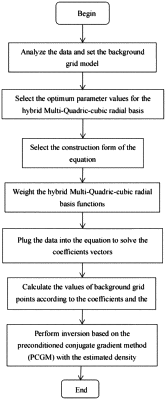| CPC G01V 7/06 (2013.01) [G01V 1/301 (2013.01); G01V 11/002 (2013.01)] | 3 Claims |

|
1. A gravity inversion method based on a meshfree method that uses a hybrid basis function to estimate a density field of known prior information and an estimated density field as an initial density for inversion, the gravity inversion method comprising the following steps:
(1) selecting an appropriate method of constructing an approximate function, and forming a hybrid radial basis function by using a Multi-Quadric (MQ) radial basis function and a cubic kernel function;
(2) using an appropriate evaluation method to select suitable parameters of the hybrid radial basis function, wherein the selected parameters of the hybrid radial basis function are weights of different components and a smoothness of a component of the MQ radial basis function;
(3) selecting a construction form of an equation, wherein strong-form construction is selected if the radial basis function has a similar form to a weak-form weight function; and weighting a distance norm of the hybrid radial basis function on a basis of a tendency and morphology of an ore body in the prior information;
(4) loading, by a computer, known underground density information of an ore body to be estimated and constructing, by the computer, an equation set by using a meshfree hybrid radial basis function collocation method;
(5) solving, by the computer, the equation set, and using, by the computer, a coefficient matrix created with an acquired coefficient vector in combination with a global background grid to obtain a global estimated density distribution;
(6) loading, by the computer, observation data and performing, by the computer, inversion by using a preconditioned conjugate gradient method (PCGM) with the global estimated density distribution as a constraint to determine an underground density distribution of the ore body to be estimated; and
(7) determining, by the computer, distribution of the ore body to be estimated based on the determined underground density distribution of the ore body to be estimated.
|